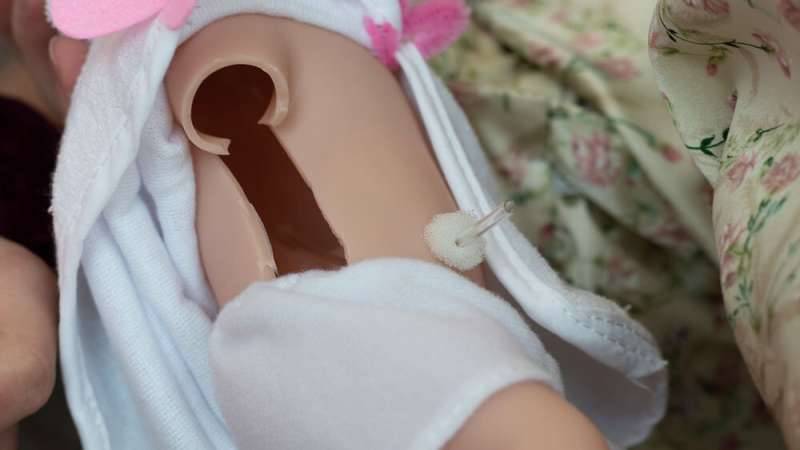This article has been reviewed according to Science X's editorial process and policies. Editors have highlighted the following attributes while ensuring the content's credibility:
fact-checked
trusted source
proofread
Texas A&M students develop device to combat kidney failure in newborns

Before a baby is born, doctors hope for a safe delivery, and parents hope for a healthy child. Unfortunately, conditions such as kidney failure can only be detected after birth and require immediate treatment. These patients need peritoneal dialysis to help regulate kidney function, and although lifesaving, this treatment can lead to fluid leakage and requires a lengthy healing process.
For their senior capstone project, a team of six students in the Department of Biomedical Engineering at Texas A&M University designed custom dialysis cuffs and a T-shaped applicator sleeve to improve the peritoneal dialysis process. The team called Rapid Cuff is sponsored by Texas Children's Hospital (TCH) and advised by Dr. Daniel Alge, associate professor in the biomedical engineering department, and his brother Dr. Joseph Alge, previously with TCH and currently a pediatric nephrologist at Arkansas Children's Hospital.
"Since neonates are the ones who use peritoneal dialysis most frequently and are completely reliant on it, they need a really good solution," said team member Naomi Brady. "Especially because it takes a week or two for the incision site to heal, and they can't receive dialysis until they heal. Making sure nothing goes wrong is critical for keeping them alive."
Rapid Cuff set out to expedite the healing process and prevent fluid leakage for newborn babies during peritoneal dialysis, a process that helps the kidneys filter waste and toxins in the blood. This outpatient operation involves implanting a catheter through the wall of the abdomen. One end remains outside the body to pass dialysis fluid through the catheter, and the other end is free-floating inside the abdomen.
"You can pass fluid through, and the waste diffuses into that fluid," Brady said. "You take the fluid out, put new fluid in and repeat that process as necessary, depending on how well the kidneys are functioning."
But what causes the kidneys to fail? Sometimes the cause is genetic, passed down from parent to child, or congenital, where the bean-shaped organs fail to develop in the womb. This is especially common in premature babies. As a result, waste and toxins accumulate and diffuse over capillaries inside the abdominal cavity.
Due to their tiny veins and small blood supply, babies with kidney failure must use peritoneal dialysis rather than hemodialysis because the tube that is inserted into the arm during hemodialysis can fall out easily if the patient moves around a lot.

Adults know to stay still when receiving treatment, but babies wiggle by nature. To prevent the tube from slipping, the team made their double-compressed cuffs squirm-proof by creating a seal that secures the catheter more safely to the body.
"The biggest thing we did was change the materials," said team member Haley Phelan. "A regular peritoneal dialysis catheter already has the cuffs on it, but they're made with polyester. We've changed that with a more porous foam filled with a hydrogel. We also added a third cuff that sits on the wound outside the body and an applicator sleeve. The sleeve better standardizes the placement of the catheters and keeps the cuffs from expanding before it is placed into the body."
"The applicator was inspired by a tampon applicator," Brady said. "You can compress the cuff so that it's extra small to fit into a smaller incision. Once you stick the catheter inside, you can pull out the applicator sleeve, while the catheter remains."
In the future, this device could be adapted to aid in the dialysis process for pediatric and adult patients with kidney failure.
As for the future of these Aggies, the team of six is divided. Hannah Bludau plans on attending SMU Cox School of Business for an MBA and working for Texas Instruments as a full-time product marketing engineer. Amelia Flug will graduate this December and plans to work as a product marketing engineer at Texas Instruments, and Mariana Cantu plans to work in the industry.
Reagan Isabell attends medical school at the Texas A&M School of Engineering Medicine. Brady also attends medical school but at the Texas College of Osteopathic Medicine, and Phelan is pursuing their master's in biomedical engineering at Texas A&M before continuing to industry.
"This project is really personal to me because I was born very premature," said Phelan. "I get to delve into that passion of mine as a student."


















